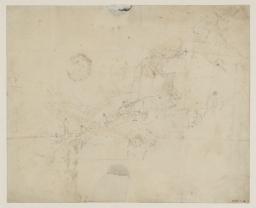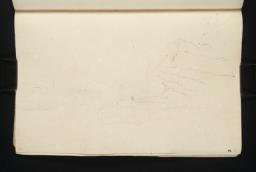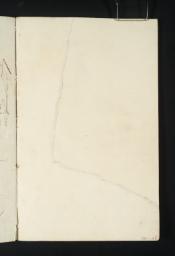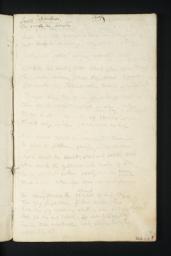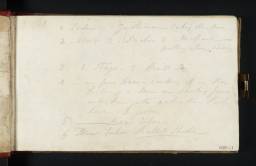Sketchbooks and Drawings Associated with Farnley Hall and Related Yorkshire Subjects c.1808–24
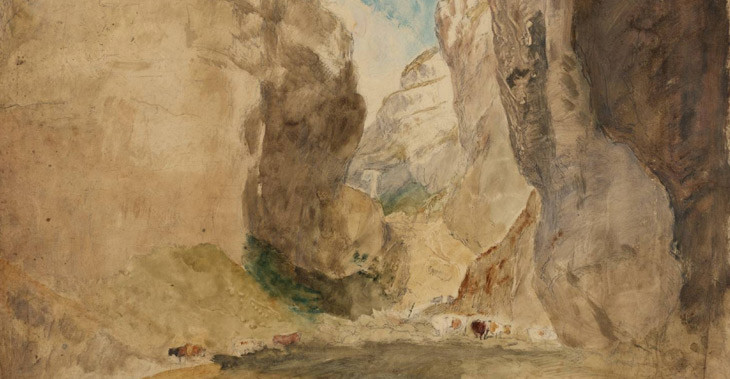
Gordale Scar c.1808
From the entry
This group brings together loose sheets and six sketchbooks associated with Turner’s visits to Farnley Hall, the Yorkshire home of his friend and patron Walter Fawkes. Farnley Hall looks south over the valley of the River Wharfe from rising ground above the small market town of Otley, about ten miles from Leeds. Walter Fawkes (1769–1825) inherited the estate from his father in 1792. His first contact with Turner dated from about 1802 when the artist made his first tour to the Alps, and over the following ten years or more Fawkes was one of the major purchasers of work resulting from that tour. Turner’s Alpine work of 1802 is grouped and introduced separately in this catalogue, and there are few if any references to it in the material grouped here. Instead, the work assembled here results directly from Turner’s visits to Farnley Hall. The earliest works in this group, in the miscellany of Farnley and related subjects, are ten large pencil drawings that form a coherent subset of sketches in the ...
Farnley and Related Subjects c.1808–1824
D12099–D12108; D12110–D12122; D40047; D40073–D40074; D40299
Turner Bequest CLIV A–J, L Xa–c
D12099–D12108; D12110–D12122; D40047; D40073–D40074; D40299
Turner Bequest CLIV A–J, L Xa–c
References
This group brings together loose sheets and six sketchbooks associated with Turner’s visits to Farnley Hall, the Yorkshire home of his friend and patron Walter Fawkes.
Farnley Hall looks south over the valley of the River Wharfe from rising ground above the small market town of Otley, about ten miles from Leeds.1 Walter Fawkes (1769–1825) inherited the estate from his father in 1792.2 His first contact with Turner dated from about 1802 when the artist made his first tour to the Alps, and over the following ten years or more Fawkes was one of the major purchasers of work resulting from that tour. Turner’s Alpine work of 1802 is grouped and introduced separately in this catalogue,3 and there are few if any references to it in the material grouped here.
Instead, the work assembled here results directly from Turner’s visits to Farnley Hall. The earliest works in this group, in the miscellany of Farnley and related subjects, are ten large pencil drawings that form a coherent subset of sketches in the Wharfe and Washburn Valleys near Farnley, including a short tour up the Wharfe from Farnley to Bolton Abbey. These are:
The present writer4 has dubbed the group the ‘Wharfedale and Washburn’ sketchbook, and although the drawings do not strictly speaking form a sketchbook they do appear to represent a single campaign. Several served as the bases of finished watercolours. A dated watercolour, Bolton Abbey from the North (British Museum, London),5 based on D12117 (Turner Bequest CLIV S) proves a date no later than the summer of 1809 for the sketches. We know that Turner visited Farnley in 18096 but there is perhaps evidence to date this group of sketches to 1808 rather than 1809. Some of their subjects, for example Barden Tower, Farnley, The Strid and Bolton Abbey occur in two lists of commissioned subjects in the Greenwich sketchbook (Tate D40668, D06824; Turner Bequest CII Inside Back Cover and 52). The first of these lists includes a note that the commission was secured ‘Per Contra’ against a draft for £100 dated ‘Feb 20’. Given the date of the British Museum Bolton Abbey the draft can belong to no later than 1809, suggesting that the sketches were made in 1808.7
There is in fact evidence for a visit to Yorkshire in 1808 when Turner also visited Tabley House, the Cheshire home of Sir John Leicester.8 The Tabley No.1 sketchbook (Turner Bequest CIII) used on that occasion also contains sketches made in Lancashire at Whalley and the Craven Dales of Yorkshire at Malham and Giggleswick. The Greenwich sketchbook lists Craven Dales subjects including Gordale and Weathercote in the same commission as the Farnley and Wharfedale subjects, suggesting that all the sketches were part of a single year’s campaign. The Craven Dales sketches relate to another pencil sketch on a large loose sheet (D02383; Turner Bequest LI P) which shows Ingleborough from Chapel-Le-Dale and formed the basis of a finished watercolour (Yale Center for British Art, New Haven, Connecticut).9
The same visit to the Craven Dales probably occasioned the large colour study of Gordale Scar included in this group (D12113; Turner Bequest CLIV O). This is one of the largest plein-air studies on paper that Turner ever attempted, and its evident ambition chimes well with the large sheets of the ‘Wharfedale and Washburn’ group which, albeit drawn in pencil only, testify to lengthy and sustained observation from nature. They also presume relatively settled weather conditions for that to have been manageable at all.
In chronological order the next period of association with Farnley clearly indicated in this material is that around 1812–13 evidenced by the Woodcock Shooting sketchbook. The title was given by Finberg in the Inventory on the grounds that one sketch (D09123; Turner Bequest CXXIX 47) served as the basis of a watercolour dated 1813 of Woodcock Shooting on the Chevin (Wallace Collection, London).10 Four further sketches (D09085, D09115, D09124, D09125; Turner Bequest CXXIX 22, 40a, 48, 49) record scenes in the neighbourhood of Farnley and justify its inclusion here. That, however, is the limit of this sketchbook’s connection with Farnley; the remaining contents range from plans for Sandycombe Lodge, the house Turner built at Twickenham, to designs for an upright classical composition.
A further important phase of connections with Farnley occurs around 1816. That year, Turner used Farnley as his base for several tours and excursions across Yorkshire, Westmorland, Cumberland and Lancashire to gather material for his illustrations to Thomas Dunham Whitaker’s proposed seven-volume General History of the County of York. The material directly relating to this campaign is so extensive, and forms such a coherent series, that it is introduced separately in this catalogue (see Introduction: Tour of Yorkshire in 1816). However, there remains some further material from this time that is more obviously associated with Farnley than with Whitaker’s project: principally the Large Farnley sketchbook, which contains one or two Whitaker-related subjects but is otherwise focused on Farnley Hall and the landscape immediately surrounding the estate, and consequently is included in the present group. Other Farnley material from about 1816, while significant in itself, appears in sketchbooks predominantly associated with other regions, tours or projects and described elsewhere in this catalogue: the Devonshire Rivers, No.3, and Wharfedale sketchbook (Tate D09789–D09855; D09857–D09888; D40878–D40884; Turner Bequest CXXXIV) and the Devon Rivers 2 sketchbook (especially Tate D09673, D09674; Turner Bequest CXXXIII 4a, 5); and the Hastings sketchbook (Tate D10343–D10348; D10350–D10408; D40814; D40843; Turner Bequest CXXXIX). All this Farnley material is datable to c.1816 while the miscellany of ‘Farnley and Related Subjects’ that begins this group contains drawings that fit into this period as well as earlier and later examples.
A group of three small sketchbooks; Scarborough 1, Scarborough 2 and The Aqueduct document a trip to Scarborough leading to a finished watercolour dated 1818 (private collection).11 There is some overlap between these and sketches in the Devonshire Rivers, No.3, and Wharfedale sketchbook. The last book records Turner’s return from Scarborough to Farnley Hall via York and Thorpe Arch, and concludes with a set of drawings made at Farnley and thereabouts.
There is also perhaps some overlap between the Scarborough group and the Yorkshire 6 sketchbook (Tate D11596–D11908; D40859; Turner Bequest CXLIX). This contains sketches at Sutton Bank near Thirsk which might feasibly have been Turner’s route to Scarborough and also sketches at Hall Beck Gill and Beamsley Beacon near Farnley which dovetail with the Large Farnley sketchbook. Nevertheless the connection with the Whitaker tour is sufficiently strong to have grouped it with Turner’s tour of Yorkshire in 1816.
The last sketchbook grouped here is the Farnley sketchbook, which can be dated to 1818 with some confidence. We do know, however that Turner continued to visit Farnley at intervals up until Fawkes’s death in 1825. Turner gave a sketchbook that he had used at Farnley in 1824 to his later friend H.A.J. Munro of Novar,12 and there are loose sheets in the Farnley miscellany here that relate to that sketchbook.13 The miscellany also contains attractive sheets connected with a project that particularly occupied Turner in his later visits to Farnley; preparing illustrations for albums and other volumes relating to Fawkes’s historical interests.
Note: Additional subsections of ‘Yorkshire Subjects around Farnley and Beyond’ and ‘Colour Studies for Subjects Commissioned by Walter Fawkes’ have been added without otherwise amending the existing text of this Introduction.
Farnley Hall remains the private home of the Fawkes family. It is perhaps best appreciated looking across the valley from one of the many fine viewpoints on the public footpaths on Otley Chevin and Caley Park.
See in this catalogue Sketchbooks Connected with Work in Sussex, Yorkshire and Cumbria for the Earls of Egremont and Lonsdale 1809. One Yorkshire sketchbook certainly dateable to 1809 and included in that group is Kirkstall Lock (Tate D12240–D12260; Turner Bequest CLV).
See in this catalogue Sketchbooks used at Tabley, Cheshire and in Derbyshire, North Wales, Lancashire and Yorkshire 1808.
See A.J. Finberg, ‘Turner’s Newly-Identified Yorkshire Sketchbook’, The Connoisseur, October 1935, pp.185–7.
How to cite
David Hill, ‘Sketchbooks and Drawings Associated with Farnley Hall and Related Yorkshire Subjects c.1808–24’, July 2010, revised by David Blayney Brown and Matthew Imms, September 2016, in David Blayney Brown (ed.), J.M.W. Turner: Sketchbooks, Drawings and Watercolours, Tate Research Publication, September 2014, https://www

